A Recipe from Rebecca: Ginger, Orange and Parsnip Scones
These buttery scones are exactly what you need to accompany a mug of tea on a cold
February day. They are easy and delicious. The parsnips are indetectable aside from the
sweet, nutty base-notes they bring to the flavour. Serve with thick cream and jam, or even on
their own, since they’re really rich and crumbly. If you left out the sugar I think they would
be good with ham and cheese, too.
Parsnip and orange scones
Makes 8 enormous scones
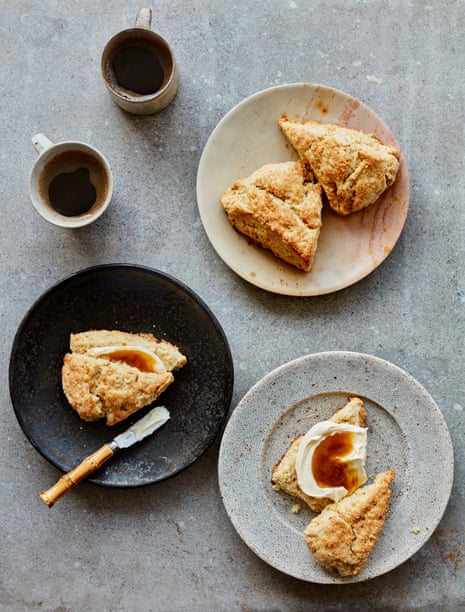
benjamina-ebuehi
Ingredients
450g plain flour
80g caster sugar
1 teaspoon ground ginger
zest of 2 oranges
1 tablespoon baking powder
¼ teaspoon salt
200g cold unsalted butter, coarsely grated
220g parsnips, peeled and coarsely grated
130ml milk, plus extra for brushing
Demerara sugar, to sprinkle over the top
Method
Heat the oven to 200C (180C fan), and line an oven tray with baking paper.
Mix the flour, sugar, ginger, orange zest, baking powder and salt in a large bowl, then add the
butter and, using your fingertips, rub it into the dry mixture until everything resembles fine
breadcrumbs. Mix in the grated parsnips.
Make a well in the centre and pour in the milk. Give the dough a quick mix, then turn it out
on to a lightly floured surface. Knead the dough quickly, bring it together and pat it into a
thick, round disc.
Cut the disc into eight triangular wedges. Put them on the baking tray, brush the tops with a
little milk and sprinkle them with demerara sugar. Bake for 20-25 minutes, until well risen
and golden.
Leave to cool, then serve with clotted cream and jam, or some butter and honey.
Recipe adapted from Benjamina Ebuehi, The Guardian, 14 Oct. 2022,
https://www.theguardian.com/food/2022/oct/14/parsnip-and-orange-scones-recipe-
benjamina-ebuehi
A Recipe from Rebecca: Sue’s Parsnip Gougères
My sister-in-law Sue makes these crunchy, cheesy little choux pastries as a special nibble for the holiday season, but they are good all year round. The mustard powder adds extra kick.
Parsnip Gougères
Ingredients
200g strong white flour
25g mustard powder
1 teaspoon ground allspice
200ml water
75g unsalted butter
1½ teaspoons salt
5 medium eggs
150g parsnip, peeled and grated
250g cheddar or stilton, broken into hazelnut-sized lumps
Method
Mix the flour, mustard powder and allspice and set aside.
Put the water, butter and salt in saucepan and bring to a boil.
As soon as the water starts to boil, tip in the dry ingredients and beat well with a sturdy whisk or wooden spoon, until a ball of dough forms in the pan and starts to come away from the sides.
Remove the pan from the heat and leave to cool for a few minutes.
Beat in the eggs one at a time, until smooth. Sue notes ‘this takes a surprising amount of elbow grease, so it will be much easier with a very sturdy stand mixer’.
Stir in the grated parsnip and transfer to a container in the fridge, where it will keep for a day or so if you want to prepare the dough in advance.
To cook, preheat the oven to 220C (200C for a fan oven). Cover a baking tray with nonstick paper. Add the cheese to the dough and stir gently. The mixture will be VERY sticky. Spoon walnut-sized dollops onto the tray and bake for about 15-20 minutes, until puffed and sizzling. You will probably need to bake this in several batches, as it is too much to fit onto a single tray.
Recipe courtesy of Sue Western.
Rebecca’s Recipe of the Week: Parsnips and Ginger
Here is another winter soup recipe from Hugh Fearnley-Whittingstall. Ginger and cayenne give a bit of a kick, while the parsnip provides a mellow, sustaining backdrop. Serve with some good bread.
Parsnip and Ginger Soup
Serves 4
Ingredients
1 tablespoon olive oil
15g butter
1 large onion, finely chopped
2 garlic cloves, finely chopped
4–5cm piece of ginger, peeled and finely chopped
¼ teaspoon ground cardamom
¼ teaspoon ground cumin
¼ teaspoon cayenne pepper
500g parsnips, peeled and cut into 1cm cubes
800ml vegetable stock
200ml whole milk
Sea salt and freshly ground black pepper (to garnish)
2–3 tablespoons flaked almonds or pumpkin seeds (to garnish)
1–2 tablespoons double cream or thick, plain (full-fat) yoghurt (to garnish)
Preparation
Heat the olive oil and butter in a saucepan over a medium-low heat and sauté the onion for about 10 minutes, until soft and translucent.
Add the garlic, ginger, cardamom, cumin and cayenne and stir for a couple of minutes. Tip in the parsnips and stir until well coated in the spices. Pour in the stock, season with salt and pepper and simmer until the parsnips are very soft – about 15 minutes.
Allow the soup to cool slightly, then purée in a food processor or blender, or using a stick blender, until smooth. Return the soup to the pan, add the milk and adjust the seasoning. Warm through gently – if the soup is a bit thick, thin it with some hot water from the kettle.
While the soup is warming, toast the almonds or pumpkin seeds in a dry frying pan until just beginning to turn golden.
Serve the soup in warmed bowls with a trickle of cream or yoghurt and the toasted almonds scattered over the top. Finish with a grinding of black pepper.
Recipe from Hugh Fearnley-Whittingstall, River Cottage Veg Every Day! (2011).
Rebecca’s Recipe of the Week: Parsnips, Squash, Capers, Parsley
Everyone knows roasted vegetables are good. Adding a punchy caper and parsley vinaigrette makes them even better. You can use different vegetables (potatoes, say), and you can also vary the vinaigrette by adding harissa paste, or using basil or mint instead of parsley.
Served with rice or another grain to soak up the vinaigrette, this makes a good weekday dinner. You can add some salted yoghurt if you want additional creaminess (and protein).
Roasted Parsnips and Squash with Caper Vinaigrette
Serves 3-4
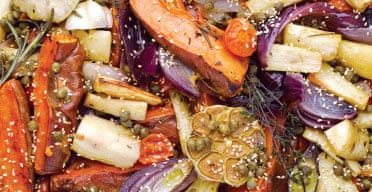
Ingredients
For the roast veg
700g parsnips, peeled
700g squash or pumpkin
120ml olive oil
4 medium red onions (optional)
4 sprigs of thyme
2 sprigs of rosemary
1 teaspoon salt
Several grinds of black pepper
1 whole head of garlic
10-20 small tomatoes, cut in half
For the dressing
1 large lemon
2 tablespoons olive oil
3 tablespoons capers, roughly chopped if they are large
1.5 teaspoons honey or maple syrup
½ teaspoon Dijon mustard
big handful of parsley, chopped fine
½ teaspoon salt
Several grinds of black pepper
Preparation
Prepare the roast veg:
Preheat oven to 190C.
Cut each parsnip into batons about 5cm long and 1.5 wide—but if they are small it is fine to leave them whole. They will look amusing in the finished dish.
Using your hand, scoop the seeds out the squash. (You can use these to make a nice nibble: https://www.101cookbooks.com/toasted-pumpkin-seeds/.) Peel the squash and cut it into chunks roughly the same size as your parsnips.
Peel the onions (if using) and cut each into 6 wedges.
Cut the head of garlic in half horizontally. Don’t break it into individual cloves or try to peel it! Just cut the whole thing into two pieces, horizontally.
Place the parsnips, squash, onions and garlic into a roasting tin and add 120ml olive oil, the thyme and rosemary, 1teaspoon salt, and some pepper. Mix well and spread it out in the pan so the vegetables are not all heaped on top of themselves. Place in the oven and roast for about 20 minutes, or until the vegetables look golden and are pretty tender.
After 20 minutes add the tomatoes, and roast for another 10 minutes or so, until the vegetables are completely tender when prodded with a fork and the tomatoes have softened.
While the vegetables are roasting prepare the vinaigrette: zest the lemon and then cut it in half so you can juice it. Combine the lemon juice (about 2 tablespoons) and zest with the other ingredients in a small bowl. Whisk to combine.
Finish the dish: Once the vegetables are done, remove them from the oven and pour the vinaigrette over the hot vegetables. Toss to combine and serve with rice or some other grain.
Recipe adapted from Yotam Ottolenghi, Plenty (2010).
Rebecca’s Recipe of the Week: Spicy Potato-Parsnip Soup with Preserved Lemon
Here is a good soup for a blustery spring day. The warming spices—cumin, coriander, paprika—give this a North African flavour, as does the preserved lemon. You can make this with any ratio of potatoes or parsnips that you prefer, including all potato or all parsnip. We enjoyed this with a glass of very robust Bulgarian merlot but other drinks are available, as they say.
Note that this involves only one pan, and so results in minimal washing-up.
Spicy Potato-Parsnip Soup with Preserved Lemon
Serves 2
Ingredients
For the Soup
2 tablespoons rapeseed or olive oil
1 onion, roughly chopped
2 garlic cloves, roughly chopped
½ dried Canalside chile, deseeded if you don’t want it too hot and chopped, or 1 medium-hot dried chile, treated similarly
1 teaspoon ground cumin
1 teaspoon ground coriander
½ teaspoon sweet smoked paprika (use a Spanish brand)
¼ cup preserved lemon, chopped fairly coarsely
500g peeled potatoes and parsnips, in any ratio (you can use all potatoes or all parsnips, too)
About 750ml stock (I think you could also use water, to be honest)
1 teaspoon salt
To decorate the Soup
4 tablespoons yoghurt
a little more smoked paprika
a little extra preserved lemon, coarsely chopped
Preparation
Heat the oil in a large saucepan over medium heat. Add the onion, garlic and chile, reduce the heat to low, and sauté gently for 10-15 minutes, or until the onion is soft but not brown. Stir in the cumin, coriander and paprika and cook for a minute or two more, until everything smells fragrant.
Meanwhile, cut the peeled vegetables into chunks of about 2cm.
When the spices in the pan are fragrant add the vegetables and the preserved lemon and pour in the stock (or water) and the salt. Bring to a simmer and cook for 30-40 minutes, or until the vegetables are very tender indeed.
Using a potato masher, mash the vegetables to give the soup a coarse texture. Hugh F-W suggests passing the whole thing through a sieve to create a smooth puree, but this seems both a lot of work and a dubious outcome as in my view a more rustic texture suits this soup far better. But it’s up to you. Add a bit of water if it still seems a bit thick to you, and check to see if it would benefit from a bit more salt.
To serve, dish your soup into bowls and garnish each with several spoonfuls of yoghurt, a sprinkling of paprika, and some golden cubes of preserved lemon.
Recipe adapted from Hugh Fearnley-Whittingstall, River Cottage Veg Every Day! (2011).
Rob’s Recipe of the Week: A Riffable Root Bake
It’s getting to that point in winter where I’m starting to run low on root veg recipe ideas again (I need to look back at the blog for inspiration!) but this simple parsnip and potato bake caught my eye. I’m sure there’s a lot of opportunity to riff on this recipe too.
Honey-Mustard Parsnip & Potato Bake
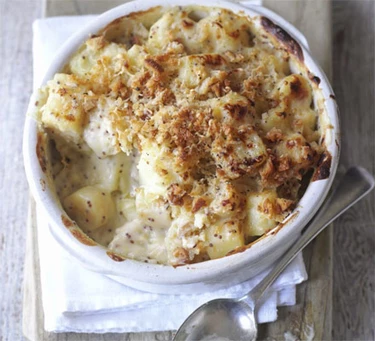
Ingredients
800g potato like Desirée, cut into 2.5cm cubes
800g parsnip , cut into 2.5cm cubes
85g butter
85g plain flour
600ml milk
2 tbsp wholegrain mustard
2 tbsp clear honey
2 tbsp white wine vinegar
85g fresh white bread , whizzed to crumbs
25g grated parmesan (or vegetarian alternative), grated
Method
Bring a large pan of salted water to the boil. Tip in the potatoes and parsnips, bring back to the boil and simmer for 5 mins. Gently drain so they don’t rough up too much, then tip into a baking dish.
(Make a bechamel) Melt the butter in a big saucepan, then stir in the flour and cook for 2 mins. Gradually stir in the milk to a smooth, lump-free sauce. Cook gently, stirring constantly, until the sauce is nicely thickened – about 5 mins. Stir in the mustard, honey, vinegar and some seasoning. Pour evenly over the potatoes. Mix the crumbs and cheese together, then scatter over the top and set aside until ready to bake. You can cover the dish and chill for up to 24 hrs before finishing.
Cook the bake at 200C/180C fan/ gas 6 for 30-40 mins until the top is crisp and golden and the sauce hot through.
From BBC Good Food
Rebecca’s Recipe of the Week: Roast Parsnips, Lentils, Cheese
Here we have a warm, sustaining main-course salad made bright with greens and the bite of mustard. It’s a good use of that parsnip that’s still in your fridge. You can make a meal of this, along with some good bread and a glass of red wine.
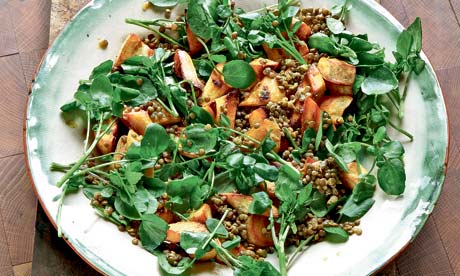
Roast Parsnip, Watercress and Lentil Salad
Serves 3
Ingredients
Salad
5 medium parsnips
2 tablespoons oil
salt and pepper
125g Puy or green lentils
2 bay leaves
1 medium onion, unpeeled
several parsley stems (optional)
several big handfuls of watercress or rocket
any hard cheese, to shave over the top
Salad dressing
1 clove garlic
½ teaspoon salt
1 teaspoon English mustard
2 teaspoons runny honey
1 tablespoon lemon juice
4 tablespoons rapeseed oil
Preparation
Preheat your oven to 190C.
Peel the parsnips and cut them into chunky batons. Toss them with the oil and a sprinkling of salt and pepper. Tip them onto a baking tray and roast for 30-40 minutes, or until they are tender and a bit golden. The time will depend on how large they are. You can poke them with a fork to see if they are soft inside. Remove from the oven and leave them to one side.
Meanwhile, prepare the lentils: cover them with boiling water and bring back to a boil. Boil for one minute, and then drain.
Return the drained lentils to the pan and add just enough water to cover them. Add the bay leaves, onion and parsley stalks (if you have any to hand). Bring to the boil, reduce to a simmer, and simmer for about 30 minutes, or until al dente. Drain and remove the bay leaves and parsley. It’s up to you either to remove the onion or to leave it in the finished salad.
While the lentils cook and the parsnips roast prepare the salad dressing. Mash the garlic with the salt in a mortar and pestle to make a smooth paste. Whisk in the other ingredients.
When the parsnips and lentils are finished, toss them, still warm, with the dressing and add the watercress or rocket. Pile onto a serving platter and shave some hard cheese over the top before serving.
Recipe adapted from Hugh Fearnley-Whittingstall, River Cottage Veg Every Day! (2011) – online at rivercottage.net
Rebecca’s Recipe of the Week: Superlative Parsnips
This is EXACTLY what you need to eat on Easter Sunday.* Whatever else you’re serving, this will make it even better. The recipe comes from Abra Berens, who recommends accompanying it with grilled duck breast and radicchio. It’s also pretty super spread on a piece of toast.
Parsnip Purée
Serves 4.
Ingredients
120ml olive oil
1 large onion, peeled and cut into thin slices
250ml white wine
900g parsnips, peeled and cut into chunks
2 teaspoons salt
250ml double cream (although we in fact substituted oatmilk)
2 star anise
Zest of one orange
Preparation
In a medium saucepan, heat a generous glug of the oil over very low heat. Add the onion and cook until very soft, for about 15 minutes.
Add the wine, and continue to cook until it’s almost completely evaporated.
Add the parsnips and salt, and toss together.
Add the cream, the remaining olive oil, and star anise. Bring to a boil, the reduce the heat so that the mixture simmers gently. Cover and cook until the parsnips are falling-apart tender, about 15 minutes more. Remove the star anise.
Purée the mixture (liquid and all) until it is very smooth. Add the orange zest and enjoy.
Recipe adapted from Abra Berens, Ruffage: A Practical Guide to Vegetables (2019).
*I expect you can work it into a Seder as well…
Rebecca’s Recipe of the Week: Parsnip and potato gnocchi with gochujang and hazelnuts
Another brilliant recipe from Meera Sodha: crispy homemade gnocchi tossed with greens and served with spicy Korean chile sauce. Gnocchi can be a little stodgy; the solution is to fry them briefly after they’ve been boiled, so the crunchy outside contrasts with the soft, pillowy inside. A simple red sauce of Korean chile paste, miso and sesame oil provides the perfect foil.
If you don’t know gochujang chile paste, you’re in for a treat. Get some at the KW Oriental Supermarket on Bath Street, or (I suppose) in major supermarkets everywhere.
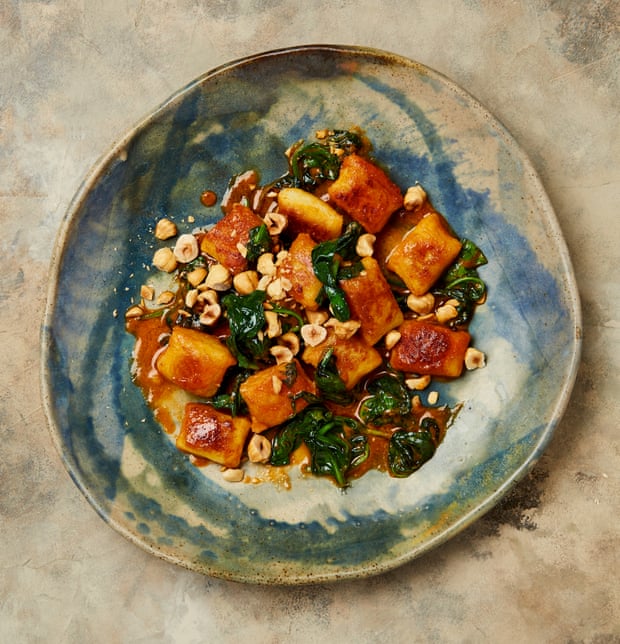
Parsnip and potato gnocchi with gochujang
Serves 2
Ingredients
250g potatoes
150g parsnips
60-100g ‘00’ flour
2 tbsp rapeseed oil, for frying
100g young spinach
25g toasted hazelnuts, chopped
for the chile sauce
4 tsp gochujang paste
4 tbsp white miso
3 tbsp toasted sesame oil
2 tbsp fresh lemon juice
Method
Put the potato and parsnips in a medium saucepan, cover with cold water and bring to a boil. Turn down to a simmer and cook until tender (15-30 minutes, depending on the size).
While the potatoes are cooking make the sauce: combine the sauce ingredients in a small bowl and mix until smooth. Set aside.
When the potatoes are tender, drain and leave to steam dry for 15 minutes. Peel and then mash until very smooth. If you have a potato ricer, this is a good moment to use it.
Add the flour to the mashed/rice potatoes and parsnip, and, using your hands, gently mix it in to form a dough. Add as much flour as you need to stop it sticking to everything, but try not to add more than that. Tip out on to a clean work surface sprinkled with a bit more flour and knead a bit to form a smooth dough.
Divide the dough in two and roll each piece into a sausage around 35cm long x 2cm thick. Cut each sausage into 2cm pieces. If you have the energy, you can use a fork to give each piece some little ridges, which will be cute and make the sauce stick a bit more to the gnocchi. To do this, roll each piece across the tines of a fork, indenting parallel ridges into the individual gnocchi (gnoccho?).
Bring a big pan of water to a rolling boil, drop some of the gnocchi in and and cook for one to two minutes, until they float to the top. Lift them out with the slotted spoon as they rise to the top and and drain in a sieve. Continue until they are all cooked.
In a medium frying pan, heat the rapeseed oil, swirling the pan gently so it coats the base. Once hot, add some of the gnocchi and fry for a couple of minutes, until golden brown underneath. Flip them over and cook for another couple of minutes, to brown the other side. Remove from the pan and then cook any remaining gnocchi.
Add the spinach to the pan and stir gently (so as not to break up the gnocchi) until it wilts. Return any remaining gnocchi to the pan and toss together.
Divide onto two plates and drizzle with a couple of tablespoons of the sauce. Sprinkle with the hazelnuts and serve with extra sauce on the side.
Recipe adapted from Meera Sodha, The Guardian, 23 Nov. 2019.
Rebecca’s Recipe of the Week: Turmeric and Lime Leaf Broth
‘A combination of lifting aromatics and wintery earthy roots, roasted until crisp around the edges and sweet’, writes Anna Jones. This flavoursome broth is satisfying and unctuous without being cloying or heavy. I think you will enjoy it. ‘Definitely one for a Canalside recipe’ said Matt when I made this.
Anna Jones notes that you can use any root vegetables that you like—beetroot or potatoes could be substituted for the carrots, parsnips and swedes.
Turmeric and Lime Leaf Broth with Roasted Roots
Serves 4.
Ingredients
200g carrots, peeled and halved if big
350g parsnips, peeled and quartered
500g swede, peeled and roughly chopped
salt and pepper, to taste
coconut oil
1 thumb-sized piece of ginger root, peeled
1 thumb-sized piece of turmeric root, peeled
1 bunch of coriander
2 large shallots, finely sliced, divided into two portions
1 clove garlic, finely sliced
1 tablespoon coriander seeds, roughly smashed
1 red chilli, finely chopped
1 x 400g tin of coconut milk
4 lime leaves
To Serve
200g cooked grains
1 lime, halved
Preparation
Preheat the oven to 220C.
Place the prepared roots into a baking tray with a big pinch of salt and 1 tablespoon of coconut oil. Put in the oven. After 5 minutes remove it and toss everything together. Return it to the oven and roast for about 35 minutes, or until everything is golden. Toss it periodically while it’s roasting.
Meanwhile prepare the broth: first grate the ginger and turmeric.
Cut off the stalks of the coriander and chop these roughly. Keep the leaves to garnish the soup.
Add another tablespoon of coconut oil to a saucepan and heat over medium heat. Add half the shallots and sauté for about 5 minutes, until they begin to brown. Add the grated ginger and turmeric, the chopped coriander stalks, the garlic, coriander seeds and chile. Sauté for a few more minutes.
Add the coconut milk and the lime leaves. Fill the empty tin with water and add this to the pan as well. Season to taste with salt and pepper and simmer for 10 minutes.
While the broth is simmering heat another tablespoon of coconut oil in a sauté pan over high heat. When it’s really hot add the remaining shallot and cook until it’s crispy and golden—but don’t let it burn. Remove the crispy shallots from the pan onto some kitchen paper. Spread them out so they don’t all stick to each other and go soggy.
Once the roots are ready, spoon the grains into four bowls. Place the roasted roots over the grains and ladle the soup over the top. Garnish with the coriander leaves and crispy shallots. Serve with the lime halves for an extra lime kick.
Recipe adapted from Anna Jones, The Modern Cook’s Year (2017).